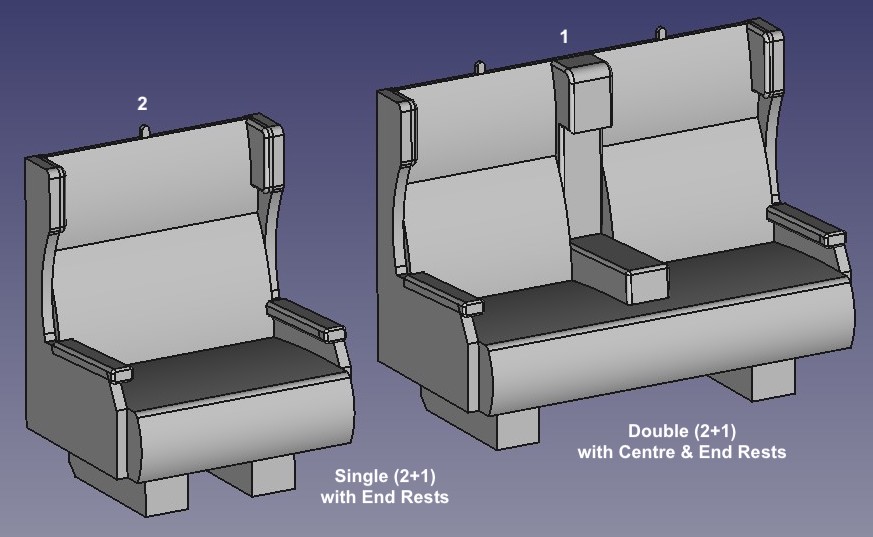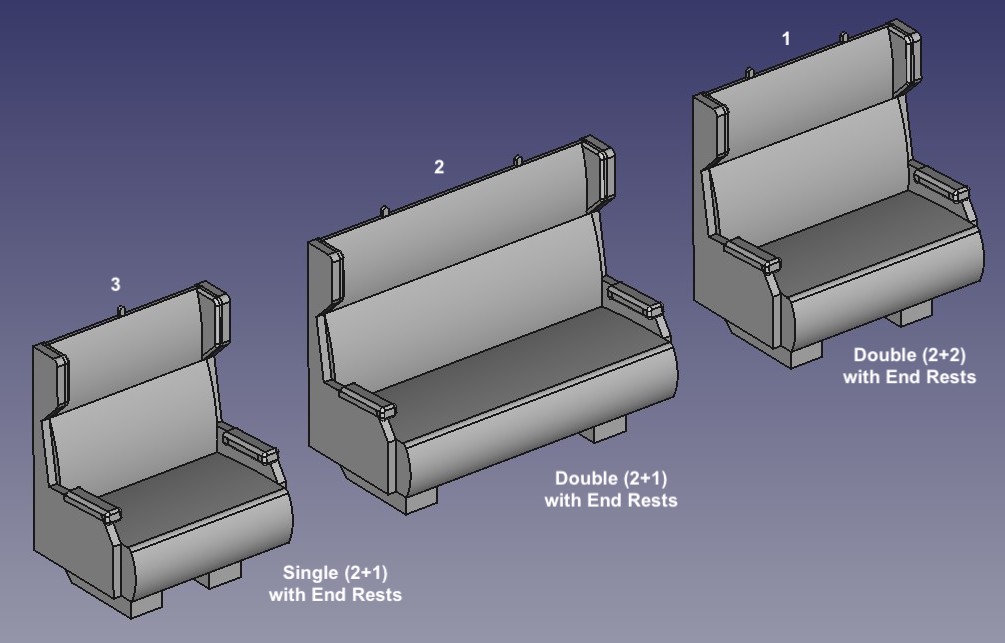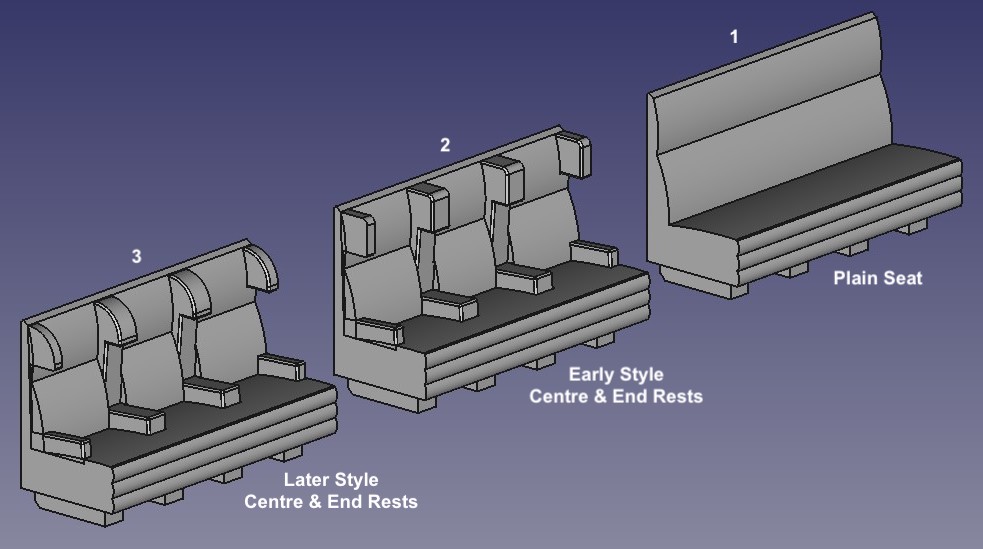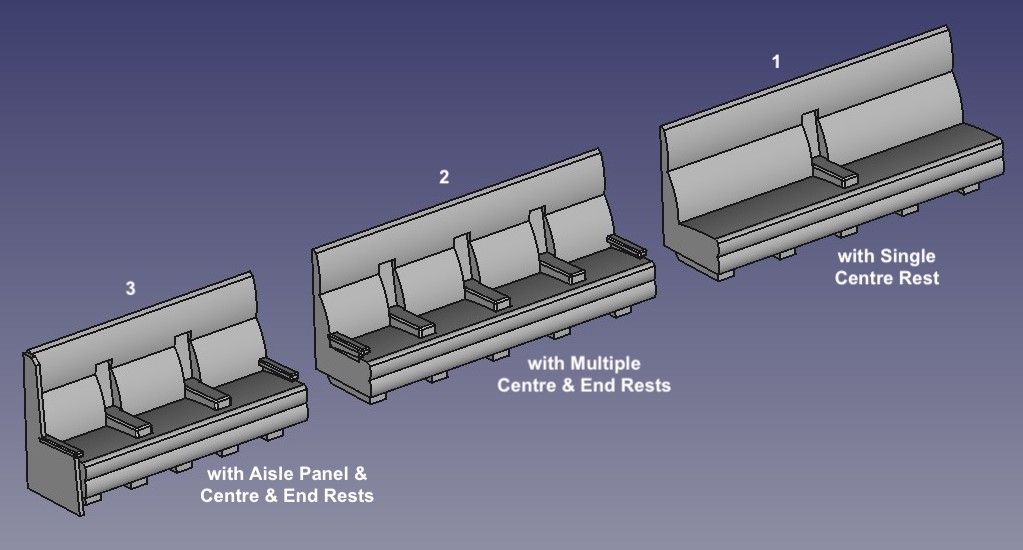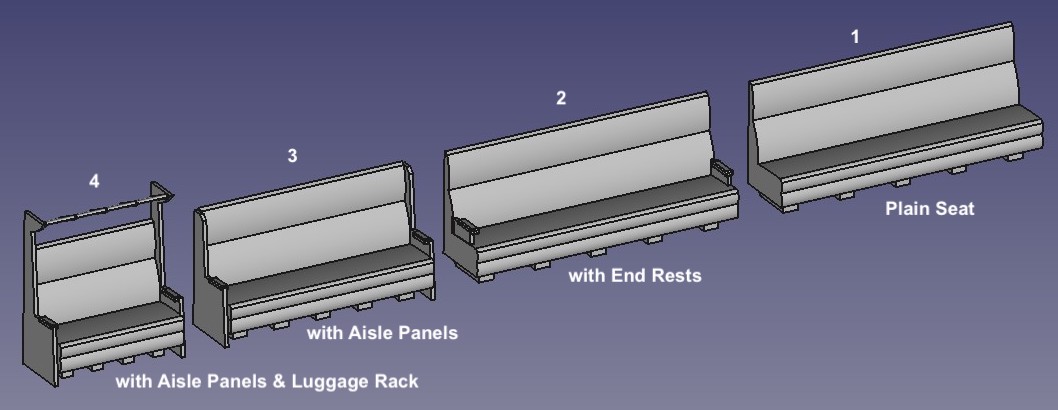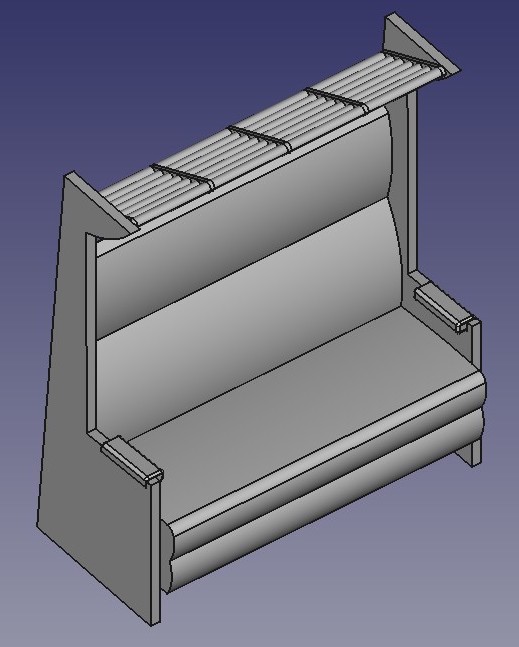Carriage Seats
Seat Types
This page describes my current range of seats for model railway carriages. These are 3D-printed in UV resin, and are available in a selection of styles, sizes, and in a variety of scales. The current range of seats is based on those fitted to BR Mk1 carriages, but are configurable for length and presence of various features, so should also be suitable for other carriage types. The range of basic seat types currently covers the bench-type seats typically used in open, corridor and suburban (i.e. non-gangway) carriages and is shown in the illustrations on the right. Individual seats for restaurant and oher special carriages should follow when I can find sufficient information.
Seats for open carriages are supplied in pairs, either two short double seats for a 2+2 seating arrangement, or a longer double seat and a single seat for a 2+1 arrangement. All other seats are supplied singly. In effect, a complete row of seats is supplied.
Although not always strictly correct to the Mk1 prototypes, all seats can be supplied:
- as a simple, plain bench seat,
- with one or more middle arm/head rests,
- with end arm/head rests intended to fit against the carriage side or corridor partition wall, and/or
- with end arm/head rest panels, for use alongside a central or side aisle.
Each end of a seat can be configured separately. Where a pair of seats is configured with different features at each end, the seats will be supplied as a mirror-image pair. For the 2+1 pair, the specification will apply to the double seat, and the single seat will be the mirror-image.
The suburban open 3rd seats can also be supplied with an overhead luggage rack supported by extended end panels, as illustrated below right. In the prototype for this the over-seat luggage rack is lower than the normal wall-mounted types, and therefore likely to be easily visible through the carriage windows. The rack itself is modelled as a closely-spaced series of round bars. In this case the ends of the seat are not otherwise configurable.
All seats are provided with simple legs that are set back from the front edge of the seat. The bottom rear edge of the legs is chamfered to fit neatly against the junction of your floor and wall. The legs can be easily filed down should your model carriage have an unusually thick or high floor. The end legs are also inset from the ends of the seat, to make some allowance for the curvature of the carriage sides.
The seat ends (and end panels) are vertical, so when configuring your seats for length you will need to allow for any curvature (tumblehome) of the carriage side walls: the top of the seats may reach the wall before the lower part of the seat reaches the floor–wall junction.
Seat Profile Dimensions
The last illustration on the right shows a typical seat profile (suburban 3rd), together with key dimensions. These dimensions for the various seat types are as follows:
| Seat Type | Back Height (in.) | Seat Width (in.) | Cushion Width (in.) | Cushion Height (in.) |
|---|---|---|---|---|
| Open 1st | 42 | 25 | 19 | 16 |
| Open 2nd/3rd | 42 | 22 | 17.5 | 16 |
| Corridor 1st | 45 | 27 | 20.5 | 16.5 |
| Corridor 2nd/3rd | 45 | 24 | 18.5 | 16.5 |
| Suburban 1st | 46 | 27 | 19 | 17.5 |
| Suburban 2nd/3rd | 46 | 24 | 17 | 16.5 |
For the seat with luggage rack, the end panel height is 60in. and the rack width is 13.5in..
End armrests are 3in. wide, while those in the middle of a seat are 6in. (1st class) or 5.5in. (2nd/3rd class) wide.
End panels are 1 inch or 0.5 mm thick, whichever is greater.
The height of the legs is about 1/3 of the Cushion Height given above, and the front of the legs are set back about 6in. behind the front of the cushion.
These dimensions refer to the prototype size; the size of the model seats will then depend on the scale chosen. Elsewhere on this page dimensions given in feet and/or inches likewise refer to the prototype size, and those in mm refer to the model size. A calculator to help convert between prototype inches and model mm is available here (opens in new window/tab).
Seat Lengths
To allow for prototypes other than the BR Mk1 carriages on which my seats are based, and to accommodate variations in wall thickness of your model carriage, the seats are configurable for length. Any end panels are included in the length specification. As a guide the seat lengths for various Mk1 carriages are as follows:
| Carriage/Seat Type | Seat Length (in.) |
|---|---|
| Open Double Seat of 2+2 | 39 |
| Open Double Seat of 2+1 | 54 |
| Open Single Seat of 2+1 | 33 |
| Compartment with Side Corridor | 75 |
| Suburban Full Width Compartment | 108 |
| Suburban with Aisle Panel at one end | 87 |
| Suburban Open with End Panels and Luggage Rack | 54 |
These lengths are based on a carriage width of 9ft (108in.) and a compartment with side corridor width of 6ft 3in. (75in.), with no allowance for wall thicknesses. When choosing your seat lengths you will need to make appropriate allowance (length reduction) for wall and partition thicknesses (and tumblehome curvature), which will depend on the method of construction of your model carriage (and also its scale).
Configure Your Seats
To order some of my seats you will need to configure each seat specification and add the appropriate quantity to your basket. Select the basic seat type (as described above) and click on the "Change Type" button. Further controls will then appear that will allow you to add appropriate arm/headrests of the type and number you require, and configure the length of your seats. Each seat (or row pair for 2+2 or 2+1 types) will cost £0.75.
A range of patterned seat cover decals is also available here to match these seat components. If you follow this link (or otherwise navigate to that page) after you have added a set of seats to your basket, the relevant seat configuration information should be carried across without you having to enter it again.
To keep the number of configuration option values down, while still covering the wide range of scales, the configurable seat length dimension is specified in scale inches, rather than model mm. A calculator and look-up table to help convert scale inches into model dimensions (or vice versa) is available here (opens in new browser tab/window).
Note: If you want a seat component that is not covered by the standard options below, I will be happy to quote you for a customised component. Please contact me with full details.

